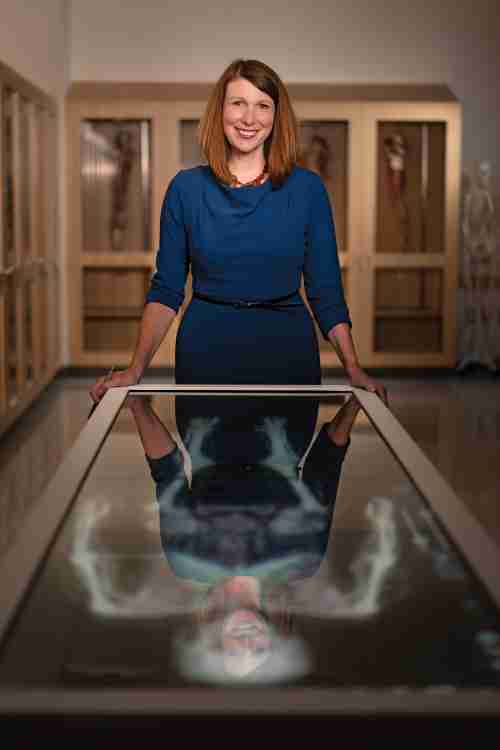The DeVos Center for Interprofessional Health includes one of the largest interprofessional, comprehensive, state-of-the-art simulation centers in Michigan. With the addition of 28,375 square feet of simulation space in DCIH, Grand Valley now has a total of more than 67,800 square feet of simulation space on its Health Campus.
The center’s advanced teaching modalities include an electronic 3D anatomy modeling and imaging table, a large collection of human plastinated specimens, high-fidelity patient simulators and several virtual reality rooms.
Katie Branch, director of Simulation, discusses the building's immersive technology and its forward-thinking design.

How was the new and expanded simulation space designed to be interprofessional?
Some spaces were intentionally designed to meet the core objectives for specific academic programs, while other spaces were designed to be inclusive and flexible for current and future academic programming. The technology within the simulation space is cutting-edge and specifically chosen to be relevant for the future.
We are looking at expanding our traditional scope in simulation to enhance student clinical skill development, learning comprehension and innovation. For example, we are partnering with the Padnos College of Engineering and Computing and the applied Medical Device Institute (aMDI) to provide health-related students the opportunity to engage with engineering students in medical product development projects.
This is the first time GVSU has had an Anatomage Table, also called a virtual anatomy table. How does it work?
The table has an electronic touch screen so students can examine and dissect different body types, genders and ethnicities. The table has learning modules including normal anatomy of both humans and animals, cellular images, and a long list of pathological conditions. Students can electronically dissect the human body, layer by layer from the skin down to the bone or look at and manipulate the heart in motion. It also allows for real CT or MRI images to be uploaded for teaching purposes.
Students must be excited to learn in the new virtual rooms.
We can project a hospital setting and have people working in the background, getting crash carts ready, stocking supplies, discussing and charting. It could be an accident scene on the side of the road where students are caring for victims and traffic is zooming by. We can also transform those spaces into home health environments where normal activity is occurring, such as the sound of a TV, the doorbell ringing or dogs barking.
Our students are really enjoying this immersive technology. We can program any environment you can find on Google Earth or we can take our own 360-degree images and sounds and program them so students can be immersed and interact in environments that they may actually experience in their professional practice.
The walls in the virtual rooms are interactive so we can program items similar to icons on a map. Students can click on the icon to gain information such as X-ray or patient lab results. The really unique feature of this technology is that it doesn’t require a headset to be able to see or interact with the imagery, allowing several students to partake in a simulation in a virtual room.
Can you describe the new operating room lab, plastinated anatomy lab and patient rooms?
The new OR lab will primarily be used in our physician assistant studies and nursing programs to teach gowning and gloving, as well as sterile techniques in surgery.
The plastinated anatomy lab on the Health Campus is quite unique. Plastinated human specimens can last indefinitely. Plastination is the scientific process invented for preserving human tissue, organs and whole bodies by removing water and fat from the tissues and replacing them with certain polymers and resins, thus preventing decay.
Our pediatric and adult standardized patient program is the most robust program in the state. We hire community members 5 weeks of age through adulthood to serve as “mock” patients for GVSU students to conduct physical and cognitive assessments. We have more than 200 pediatric and adult standardized patients in our pool. Prior to the opening of DCIH, we had eight standardized patient exam rooms and we now have 24. This expansion will allow us to accommodate the increasing demand for standardized patient events and foster collaboration among several health care disciplines at a time.
The high-fidelity patient simulators can do some pretty remarkable things to help students learn and practice their skills.
Yes. Being a centralized service at the university allows for all equipment, including the high-fidelity patient simulators, to be utilized by any health-related academic program on campus. The high-fidelity patient simulators or mannequins can be programmed and manipulated to mirror the physical traits of a human. They can be programmed to talk, display a range of medical conditions, recognize medications administered and even give birth.
Describe the new state-of-the-art recording system throughout the simulation center.
Almost all of our areas are camera equipped. We record and livestream video for faculty to watch in real time to make annotations right into the student videos to note what students have done well and what they may need to work on. Students have access to their recorded videos for self-assessment after graduating. Recordings also help us examine our simulations and make adjustments to enhance or improve the students’ learning experiences in the Simulation Center.

Katie Branch stands in the Collaborative Practice Lab, which features immersive technology on three walls. (Amanda Pitts)






